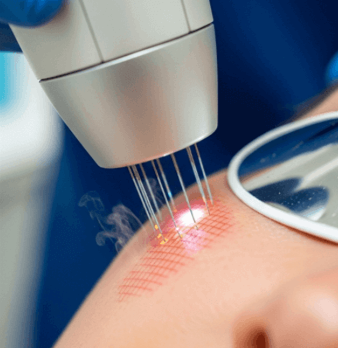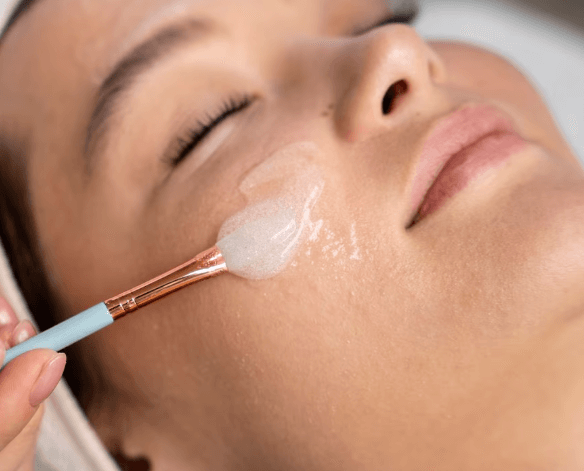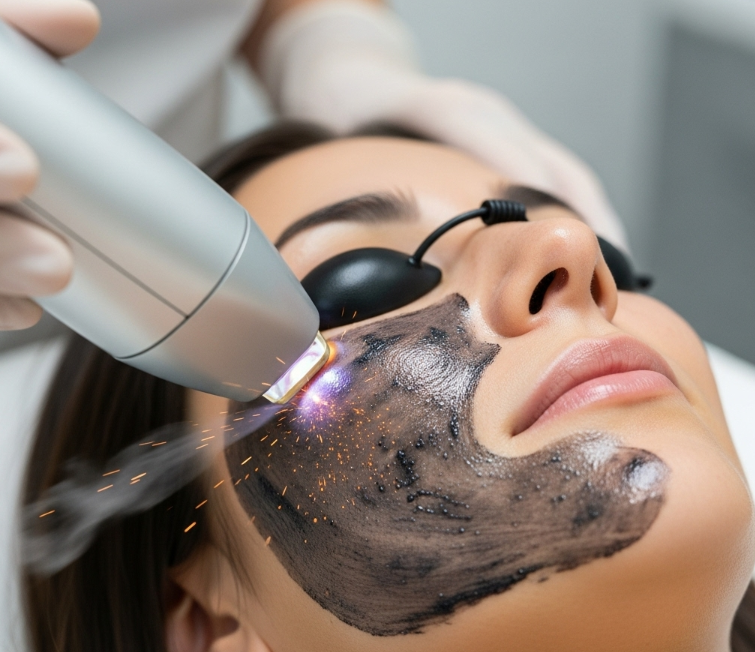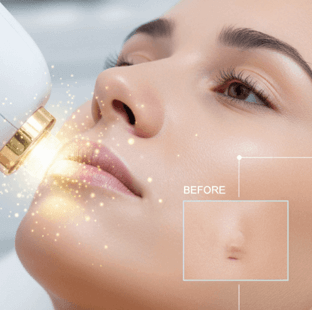Treatment Overview
Fractional lasers are a leading dermatological option in Korea for treating persistent redness, flushing, and post-inflammatory erythema, especially in patients with rosacea, acne scarring, or sensitive vascular-prone skin. Unlike vascular-targeting lasers (such as PDL or V-Beam), fractional lasers work by creating controlled microthermal zones in the skin, stimulating collagen remodeling, improving skin texture, and reducing lingering redness by strengthening the dermal matrix and enhancing microvascular stability.
In Korean dermatology, fractional lasers (such as Fraxel, Mosaic, and fractional CO₂/Er:YAG systems) are frequently combined with anti-redness lasers, cooling therapies, and infusion treatments for comprehensive redness management. Their dual action of vascular support and texture improvement makes them particularly effective for patients with both redness and acne-related skin changes.
For redness and flushing, Fractional Laser Therapy:
- Improves post-acne erythema and vascular sensitivity.
- Stimulates dermal collagen to support fragile vessels.
- Reduces skin flushing and uneven tone.
- Enhances absorption of topical redness-reducing serums and creams.
Purpose & Benefits
- Erythema Reduction: Helps fade post-inflammatory redness and supports rosacea treatment.
- Skin Remodeling: Stimulates collagen to strengthen vessel walls.
- Flushing Control: Improves vascular stability and reduces heat sensitivity.
- Dual Benefits: Treats redness + texture issues simultaneously.
- Combination-Friendly: Works well with PDL/V-Beam, cooling therapies, and erythema-reducing creams.
Ideal Candidates
Fractional Laser Therapy in Korea is recommended for:
- Patients with post-acne erythema and redness.
- Individuals with rosacea and vascular sensitivity who also have texture concerns.
- Adults with diffuse flushing resistant to topicals or antibiotics.
- Patients seeking dual treatment for redness and scarring.
- Those enrolled in clinic-supervised multi-step skin programs.
Comparison with Other Treatments
- Fractional Lasers (Fraxel, Mosaic, CO₂, Er:YAG): Reduces redness + improves texture; good for dual skin concerns.
- Vascular Lasers (PDL, V-Beam, Nd:YAG): Most effective for shrinking visible vessels and flushing.
- Antibiotics (Doxycycline, Minocycline): Internal anti-inflammatory; no texture benefits.
- Beta-Blockers (Propranolol, Carvedilol): Reduce adrenaline-driven flushing; systemic therapy.
- Chemical Peels (Gentle Korean-style): Improve post-acne redness, but less collagen stimulation.
- Cooling Masks: Immediate redness relief, short-term soothing.
- Erythema-Reducing Creams: Daily topical redness control; no skin remodeling.
Possible Risks & Complications
Fractional lasers are safe in Korean clinics, but may cause:
- Temporary redness and swelling for 1–3 days.
- Mild peeling or bronzing effect during recovery.
- Increased photosensitivity (sun protection is essential).
- Rare risk of hyperpigmentation in darker skin types.
- Flare-ups if performed too aggressively on active rosacea.
Surgical Techniques Used
- Fractional Photothermolysis: Laser delivers microscopic thermal zones into the dermis, leaving healthy skin intact for faster healing.
- Device Options: Fraxel, Mosaic, fractional CO₂, or fractional Er:YAG lasers depending on redness severity.
- Session Frequency: Typically 3–5 sessions spaced 3–6 weeks apart.
- Combination Approach: Fractional lasers used alongside vascular lasers for optimal redness and flushing reduction.
- Clinic Integration: Cooling masks, LED calming, and soothing serums applied immediately post-session.
Recovery & Aftercare
- First 2–3 Days: Mild redness, swelling, and tightness; skin feels warm.
- 1 Week: Redness subsides, peeling may occur; tone starts evening out.
- 2–4 Weeks: Collagen remodeling improves redness and skin texture.
- Maintenance: Periodic sessions recommended for stable results.
Aftercare Tips:
- Avoid direct sun exposure; use SPF 50+ daily.
- Apply soothing creams with Centella, panthenol, or madecassoside.
- Avoid retinoids, acids, or harsh exfoliants for at least 1–2 weeks.
- Stay hydrated and use gentle cleansers.
Results & Longevity
- Short-Term (1–2 Weeks): Noticeable reduction in post-acne redness and skin flushing.
- Medium-Term (1–2 Months): Improved tone and texture; stronger vascular stability.
- Long-Term: Sustained redness control with yearly maintenance sessions.
Treatment Process in Korea
- Consultation & Diagnosis – Dermatologist assesses redness, flushing severity, and skin condition.
- Preparation – Skin cleansed, numbing cream applied.
- Laser Procedure – Fractional laser delivered across target areas.
- Clinic Add-Ons – Cooling masks, LED therapy, and infusion serums applied post-treatment.
- Follow-Up – Sessions scheduled every 3–6 weeks for cumulative results.
Why Korea is a Top Destination
- Advanced fractional laser technologies (Fraxel, Mosaic, CO₂, Er:YAG) widely available.
- Korean dermatologists emphasize gentle protocols tailored to redness-prone skin.
- Affordable compared to Western dermatology centers.
- Integrated aftercare: cooling masks, LED therapy, barrier infusions.
- Korea is globally recognized for combination treatments addressing redness and texture simultaneously.
Cost Range (Detailed Breakdown)
Pricing for Fractional Laser Therapy in Korea for redness & flushing:
- Single Fractional Laser Session: USD 200 – 500.
- Package of 3–5 Sessions: USD 800 – 2,000.
- Consultation Fee: USD 20 – 50.
- Clinic Add-Ons (Cooling masks, infusions, LED therapy): USD 50 – 150.
- Premium Fractional Redness Program (Fractional + Vascular Laser + Infusions): USD 1,200 – 3,000.
Additional Costs in Korea:
- Post-care creams (Centella, madecassoside, panthenol): USD 30 – 80.
- Medical sunscreens for sensitive skin: USD 20 – 50.
💡 Patients often call fractional lasers the “texture + redness reset treatment”, since they not only fade erythema but also improve skin structure and resilience.
Popular Clinics in Seoul
- Oracle Dermatology – Fractional Fraxel + V-Beam combo programs.
- Banobagi Dermatology – Redness + texture programs using fractional Mosaic lasers.
- Renewme Skin Clinic – Fractional CO₂ for post-acne erythema + infusion therapy.
- View Plastic & Dermatology – Fractional + anti-redness lasers with LED aftercare.
- Chaum Anti-Aging Center – Premium fractional + vascular laser programs with regenerative infusions.




